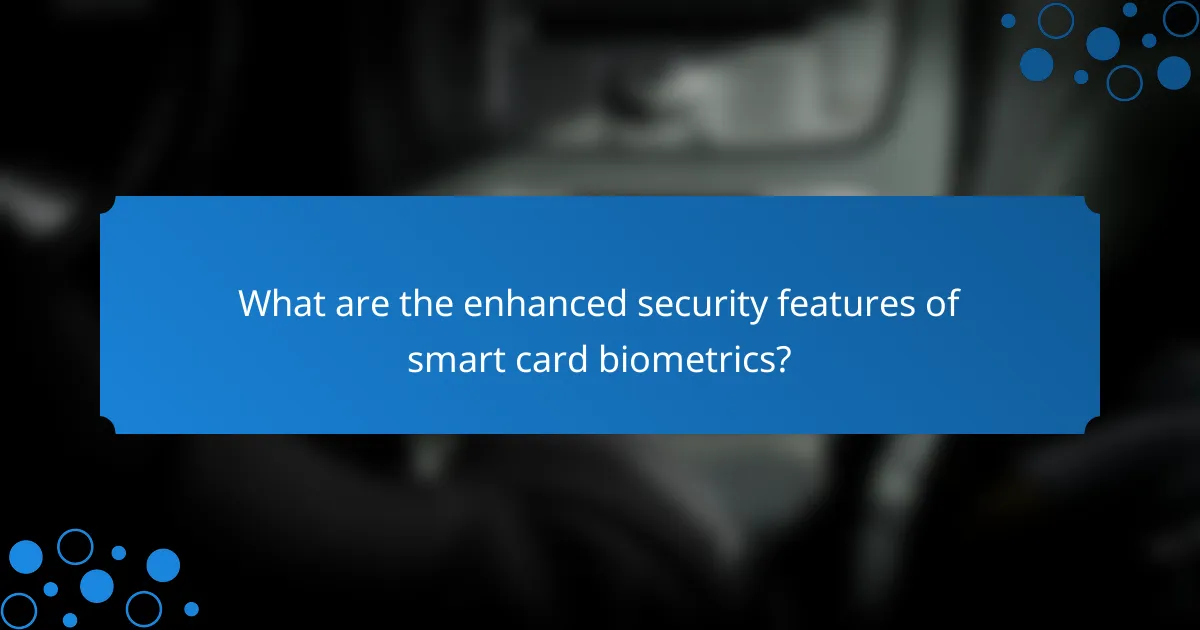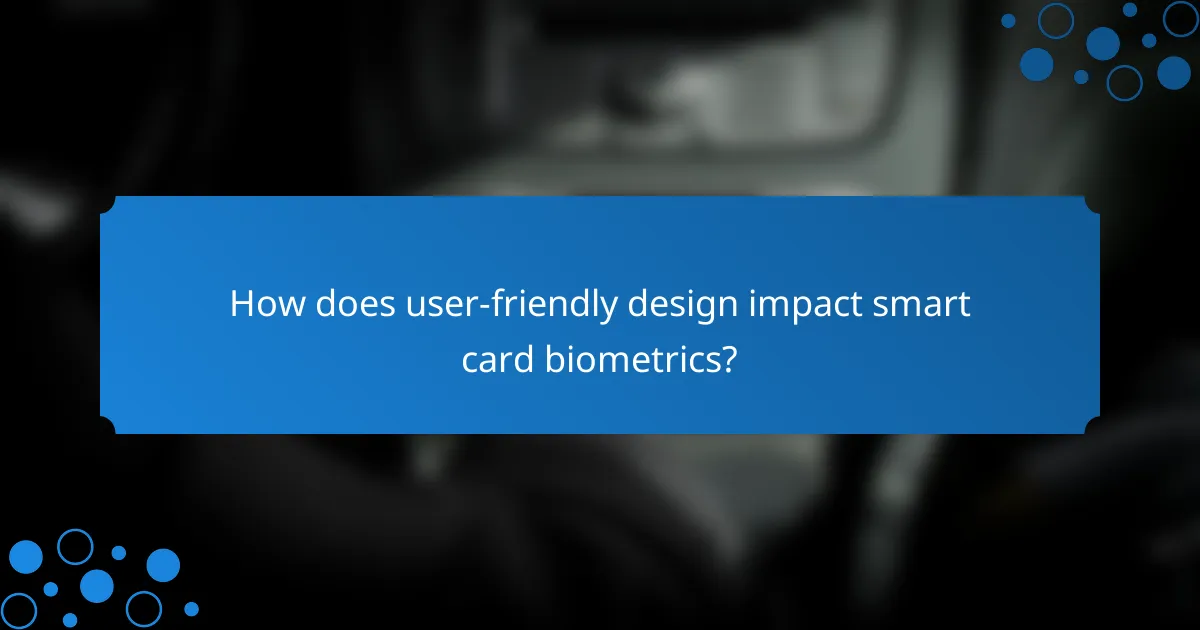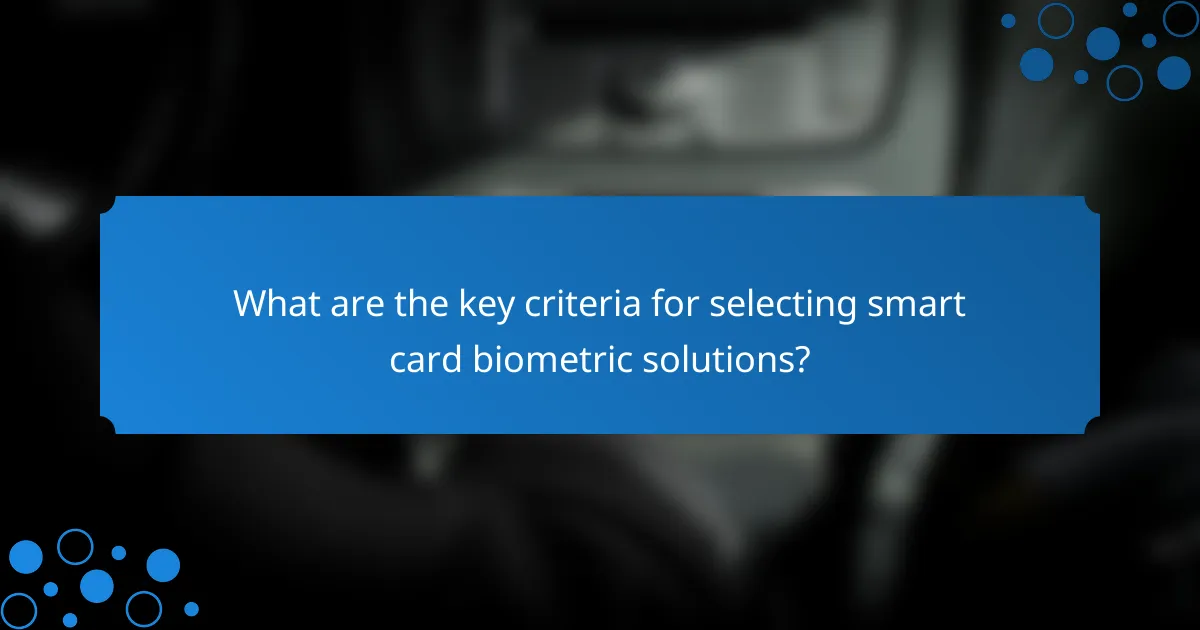Smart card biometrics combine unique physical characteristics for user authentication, significantly enhancing security and reducing the risks of unauthorized access and identity theft. With a focus on user-friendly design, these systems improve accessibility and streamline the authentication process, leading to higher user satisfaction. The market for smart card biometrics is poised for substantial growth, driven by the increasing demand for secure identification solutions across various sectors.

What are the enhanced security features of smart card biometrics?
Smart card biometrics enhance security by integrating unique physical characteristics for user authentication. These features significantly reduce the risk of unauthorized access and identity theft.
Fingerprint recognition
Fingerprint recognition is one of the most widely used biometric features in smart cards. It captures the unique patterns of ridges and valleys on a person’s fingertip, allowing for quick and reliable identification. This method typically requires only a few seconds for scanning and verification.
When implementing fingerprint recognition, ensure that the scanner is of high quality to minimize false rejections and acceptances. Users should be aware that environmental factors, such as moisture or dirt on fingers, can affect accuracy.
Iris scanning
Iris scanning offers a highly secure biometric option by analyzing the unique patterns in the colored part of the eye. This method is considered one of the most accurate forms of biometric identification, with a low probability of false matches.
While iris scanning provides robust security, it may require specific lighting conditions and a clear line of sight to the scanner. Users should be prepared for a slightly longer scanning time compared to fingerprint recognition.
Facial recognition
Facial recognition technology uses algorithms to identify and verify individuals based on facial features. This method is user-friendly, as it often requires no physical contact with the smart card.
However, the effectiveness of facial recognition can be influenced by factors such as lighting, angle, and facial obstructions. Users should ensure that their faces are unobstructed and well-lit for optimal performance.
Encryption protocols
Encryption protocols are essential for protecting the data stored on smart cards. These protocols ensure that biometric data is securely transmitted and stored, making it unreadable to unauthorized users.
Common encryption standards include AES and RSA, which provide varying levels of security. Users should verify that their smart card employs strong encryption methods to safeguard sensitive information.
Anti-spoofing technology
Anti-spoofing technology helps prevent unauthorized access by detecting attempts to use fake biometric samples, such as photographs or molds. This feature enhances the reliability of biometric systems by ensuring that only genuine users can gain access.
When selecting a smart card biometric system, look for features like liveness detection, which assesses whether the biometric sample is from a live person. This adds an extra layer of security against spoofing attempts.

How does user-friendly design impact smart card biometrics?
User-friendly design significantly enhances the effectiveness of smart card biometrics by making them easier to use and more accessible. A well-designed interface can streamline the authentication process, reduce user errors, and improve overall satisfaction with the technology.
Intuitive interfaces
Intuitive interfaces in smart card biometrics simplify user interactions, allowing individuals to navigate the system with minimal training. Clear visual prompts and straightforward instructions help users understand how to authenticate themselves quickly. For example, a simple touch or swipe action can replace complex sequences, making the process seamless.
Ergonomic card design
Ergonomic card design focuses on the physical comfort and usability of smart cards. Cards that fit comfortably in the hand and are easy to insert into readers reduce strain during use. Features such as rounded edges and lightweight materials can enhance the user experience, encouraging more frequent use and reducing the likelihood of mishandling.
Accessibility features
Accessibility features in smart card biometrics ensure that all users, including those with disabilities, can effectively utilize the technology. This may include tactile elements for visually impaired users or audio prompts for guidance. Implementing these features not only broadens the user base but also complies with accessibility standards, fostering inclusivity.
Integration with mobile devices
Integration with mobile devices allows smart card biometrics to leverage the widespread use of smartphones for authentication. Users can manage their biometric data and access services through mobile apps, enhancing convenience. This integration often includes features like NFC (Near Field Communication) for quick and secure transactions, making the technology more versatile and user-friendly.

What is the market growth outlook for smart card biometrics in Canada?
The market growth outlook for smart card biometrics in Canada is promising, driven by increasing demand for secure identification solutions across various sectors. As organizations prioritize enhanced security features, the adoption of biometric smart cards is expected to rise significantly over the coming years.
Projected market size
The smart card biometrics market in Canada is anticipated to reach several hundred million Canadian dollars within the next few years. Analysts project a compound annual growth rate (CAGR) in the double digits, reflecting strong interest from both public and private sectors.
Factors contributing to this growth include the rising need for secure access control systems and the integration of biometric technology in various applications, such as financial services and healthcare.
Key growth drivers
Key growth drivers for smart card biometrics in Canada include heightened security concerns and regulatory requirements for identity verification. Organizations are increasingly adopting biometric solutions to comply with standards such as the Personal Information Protection and Electronic Documents Act (PIPEDA).
Additionally, advancements in technology, such as improved fingerprint and facial recognition systems, are making biometric smart cards more accessible and user-friendly, further fueling their adoption.
Competitive landscape
The competitive landscape for smart card biometrics in Canada features a mix of established players and emerging startups. Major companies are focusing on innovation and partnerships to enhance their offerings and capture market share.
Key competitors include firms specializing in biometric hardware and software, as well as those providing integrated security solutions. This competition drives continuous improvements in technology and user experience.
Investment trends
Investment in smart card biometrics is on the rise, with venture capital and government funding supporting research and development. Companies are increasingly investing in enhancing biometric technologies to improve accuracy and reduce costs.
Furthermore, partnerships between tech firms and financial institutions are becoming common, as both sectors recognize the potential of biometric smart cards to enhance security and streamline operations.

What are the key criteria for selecting smart card biometric solutions?
When selecting smart card biometric solutions, prioritize security compliance, integration capabilities, and user adoption rates. These factors ensure that the solution meets regulatory standards, works seamlessly with existing systems, and is accepted by users.
Security compliance standards
Security compliance standards are critical in selecting smart card biometric solutions. Look for solutions that adhere to recognized standards such as ISO/IEC 19794 for biometric data interchange and FIPS 201 for personal identity verification in the U.S. Compliance with these standards helps ensure robust security and interoperability.
Additionally, consider local regulations that may apply, such as GDPR in Europe, which governs data protection and privacy. Ensuring compliance with these regulations can prevent legal issues and enhance user trust.
Integration capabilities
Integration capabilities determine how well a biometric solution fits into your existing infrastructure. Choose solutions that offer APIs or SDKs for easy integration with current systems, such as access control or identity management platforms. This can significantly reduce implementation time and costs.
Evaluate the compatibility of the biometric solution with various operating systems and hardware. Solutions that support multiple platforms can provide greater flexibility and scalability as your organization grows.
User adoption rates
User adoption rates are essential for the success of any biometric solution. High adoption rates indicate that users find the technology intuitive and beneficial. Solutions that offer a user-friendly interface and clear instructions tend to see better acceptance.
To encourage adoption, provide training sessions and support resources. Gathering user feedback can also help identify areas for improvement, ensuring that the solution meets user needs effectively.

How do smart card biometrics compare to traditional security methods?
Smart card biometrics offer a more secure alternative to traditional security methods, such as PINs and passwords, by using unique biological traits for authentication. This technology enhances security by reducing the risk of unauthorized access and identity theft.
Advantages over PINs
Smart card biometrics eliminate the need for users to remember complex PINs, which can be forgotten or stolen. Instead, they rely on unique physical characteristics, such as fingerprints or facial recognition, making unauthorized access significantly more difficult.
Additionally, biometric systems can provide a faster authentication process. Users can gain access in seconds, whereas entering a PIN may take longer and is prone to errors, especially under stress.
Cost-effectiveness
While the initial investment in smart card biometric systems may be higher than traditional methods, they can lead to long-term savings. Reduced fraud and lower costs associated with password resets and security breaches can offset the upfront expenses.
Moreover, as technology advances, the costs of implementing biometric systems are decreasing, making them more accessible for businesses of all sizes. Organizations can expect a return on investment through enhanced security and operational efficiency.
Scalability
Smart card biometric systems are highly scalable, allowing organizations to easily expand their security measures as needed. This adaptability is crucial for businesses that may grow or change in size and scope over time.
For instance, adding new users or integrating additional biometric modalities can often be accomplished with minimal disruption. This flexibility ensures that security measures can evolve alongside the organization’s needs without requiring a complete overhaul of existing systems.
